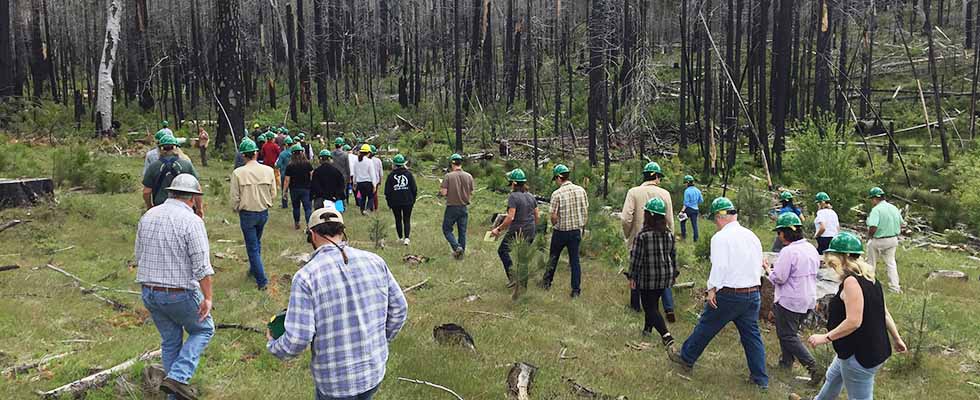
Participants in the Rim Fire Forest Resilience Tour hosted by the Sierra Nevada Conservancy in 2019 (Photo: Deb Kollars/CAFwd)
The gifts of headwater forests – trees in abundance, water supplies, wildlife habitat, recreational assets and more – benefit not only those who live nearby but people throughout California. As a new report by the Public Policy Institute of California (PPIC) explains, the state urgently needs to accelerate forest management practices that can protect those benefits in the face of increasing wildfires and other threats.
During an online event attended by 500 people last week, the authors of the report, “The Benefits of Headwater Forest Management,” described how California’s headwater forests have become more homogeneous and overgrown, with fewer large trees and more small trees, and thus more vulnerable to major wildfires and droughts.
The report focuses on approximately 10 million acres of mixed-conifer forests in the mid-elevations of the western Sierra Nevada and southern Cascade mountain ranges. More than half of California’s surface water supply originates in this region as rain or snow.
“Fuels have been building up in these forests for decades,” Henry McCann, research associate at the PPIC Water Policy Center, explained during the online event. It will take “a heavy lift,” he said, to manage such forests to create a healthier and more resilient “mosaic structure” with a variety of tree densities, canopy openings and tree sizes. Thinning and vegetation management, prescribed fire, and well-planned reforestation practices are all key.
According to the report, improving forest health can bring many benefits, including:
- Supporting the well-being of rural communities
- Reducing smoke impacts on public health
- Storing carbon and reducing greenhouse gas emissions
- Protecting water quality
- Increasing water supply
Beneficiaries can be found far beyond the headwater forests themselves. For example, the state’s headwater forests are a vital source of water to users downstream, including Central Valley farms, Silicon Valley businesses and Southern California communities, and are a key means of carbon sequestration, which benefits the entire state and beyond. Creating healthier forests can reduce the widespread damage that wildfires bring, including loss of life and property, public costs for firefighting and recovery, disruption to local and regional economies, ecosystem harms, and heavy smoke that can travel and settle many miles away.
The new report noted that understanding these benefits and beneficiaries is an important step in generating the necessary policy discussions and motivating long-term investments in effective forest management.
During the virtual event, several panelists underscored the facts and principles contained in the new report. Carmen Tubbesing, a U.C. Berkeley PhD candidate studying forest disturbances including wildfires, droughts and pests, described the importance of valuing the “ecosystem services” that headwater forests provide for people, communities and other ecosystems. She emphasized that opportunities exist for “win-win scenarios” in which strategically applied forest management practices can help to create healthier forests and reduce risks.
Willie Whittlesey, general manager of the Yuba Water Agency in Northern California, noted that, although the agency’s primary functions include water management activities such as hydroelectric power generation and providing agricultural irrigation water, the agency sees the value of engaging in forest resilience work to prevent catastrophic wildfires in the watershed that could impact water supplies. The agency currently is engaged in extending forest management activities to 275,000 acres in the North Yuba Watershed under a new collaborative partnership involving nine entities.
“We’re starting to take action on large-scale projects,” Whittlesey said. “We consider ourselves stewards of the land. We want to work with others and collaborate to restore the forests to a resilient condition.”
Angela Avery, executive officer of the Sierra Nevada Conservancy, said she appreciated the report’s emphasis on opportunities for those who benefit from headwater forests to become more engaged in landscape restoration efforts. Such work is central to the Conservancy’s mission. In addition to advocacy, policy development and funding, she said it will also be important for beneficiaries to think more about the economic systems that can lead to greater forest resilience.
“We really need a wood processing infrastructure across the Sierra Nevada if we’re truly going to manage our forests to resilience,” Avery said. Such efforts should include research and development to promote wood products innovations and markets, building up the necessary workforce, and developing small businesses. Partnerships involving public and private entities, as well as urban and rural interests, will be essential, she said.
Such efforts and partnerships are among the strategies being explored through the California Economic Summit to reduce wildfires, create more climate resilient landscapes, help create jobs and revitalize rural economies. The Summit’s recently released report, “California’s Wildfire Crisis: A Call to Action,” outlines the key principles that are foundational to solving the crisis, including acting with greater urgency and collaboration to accelerate the pace and scale of forest treatments and wood product industry development.

